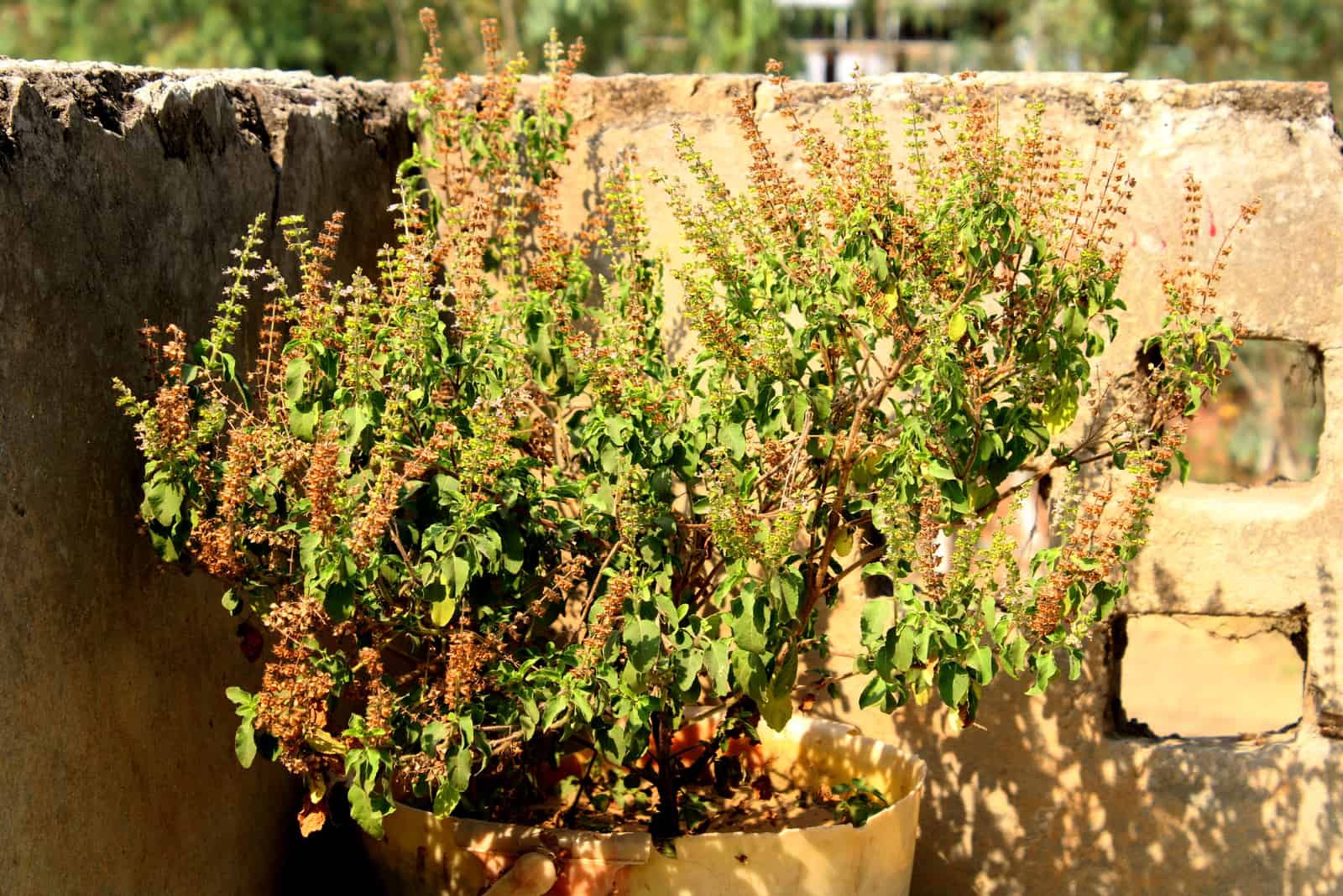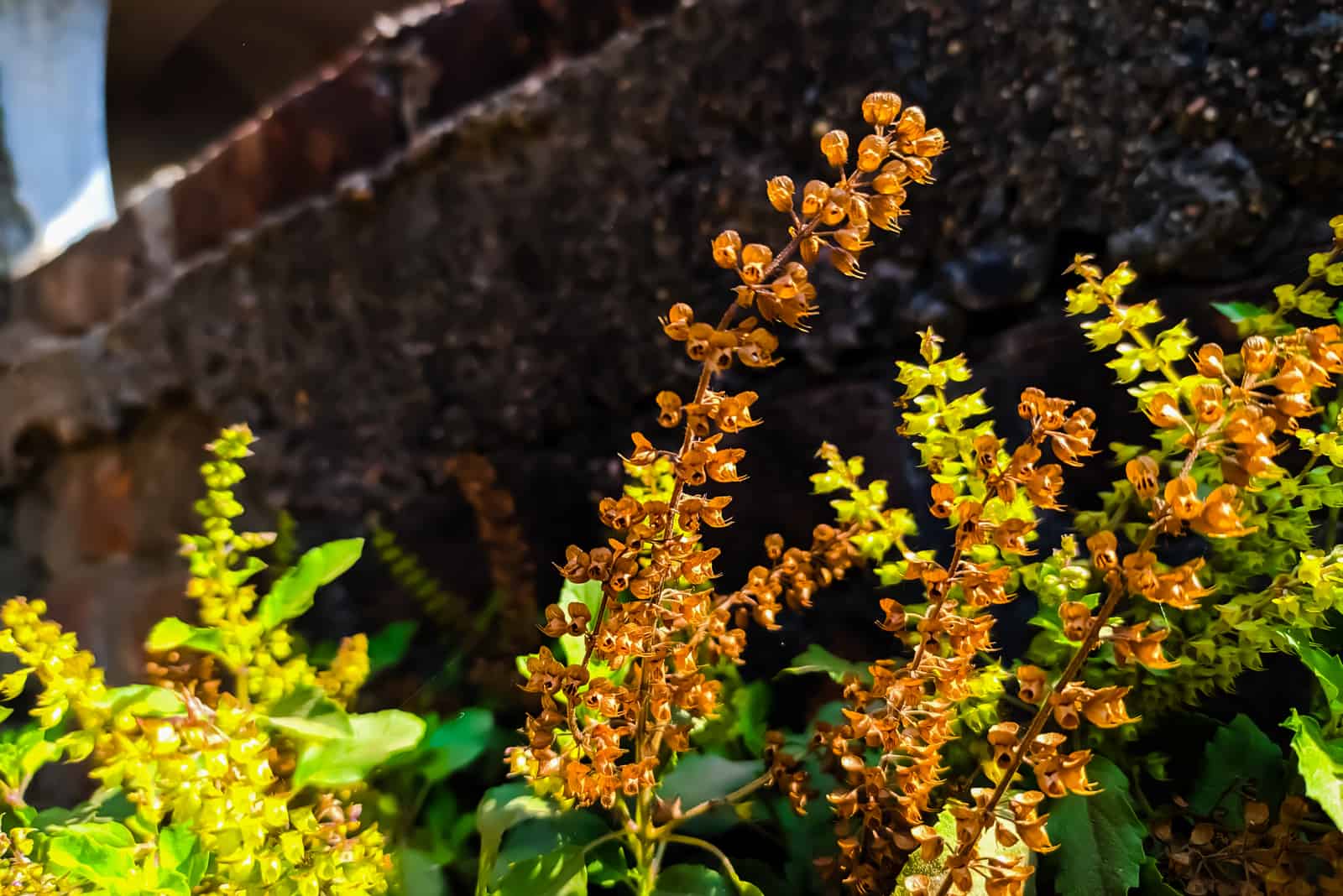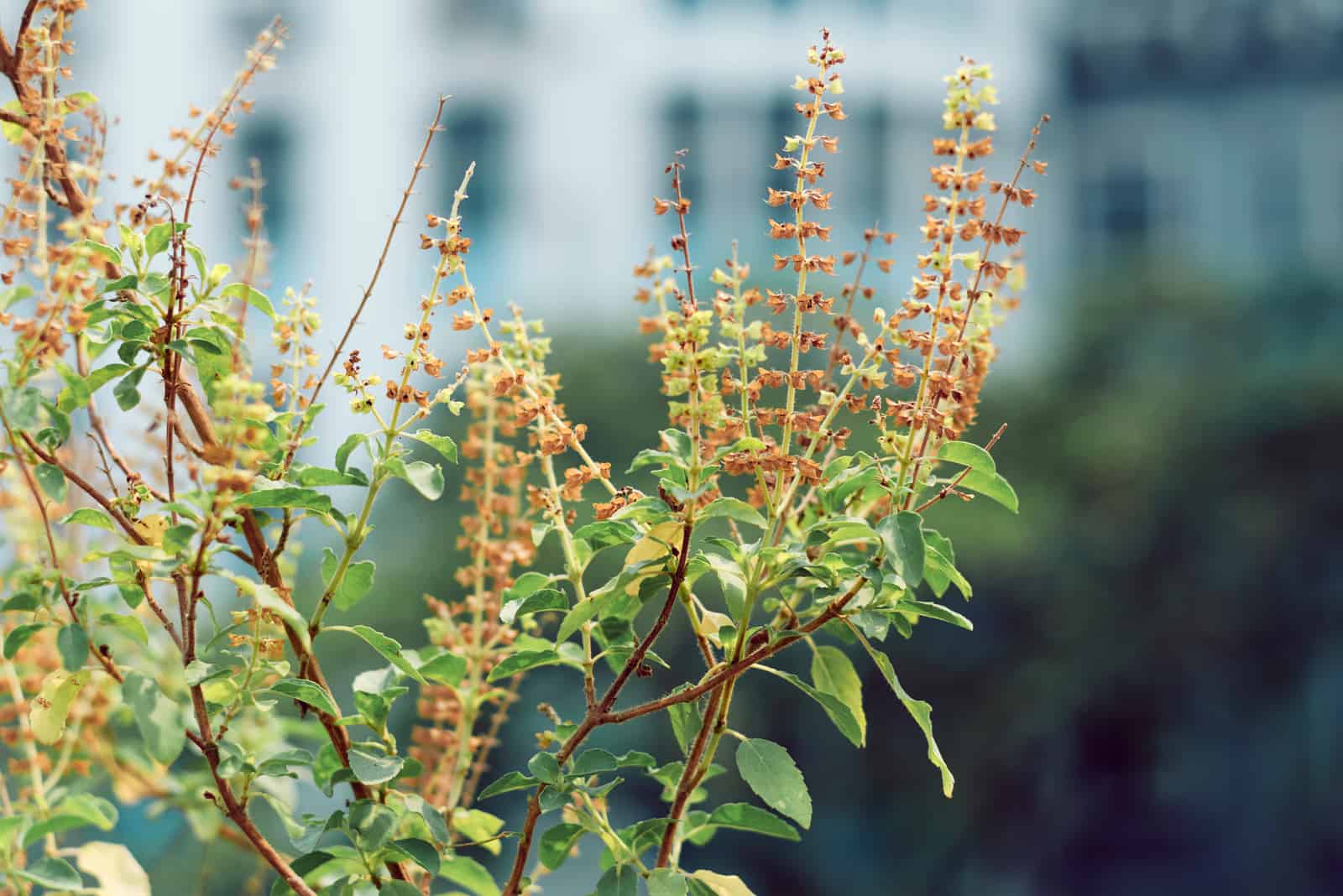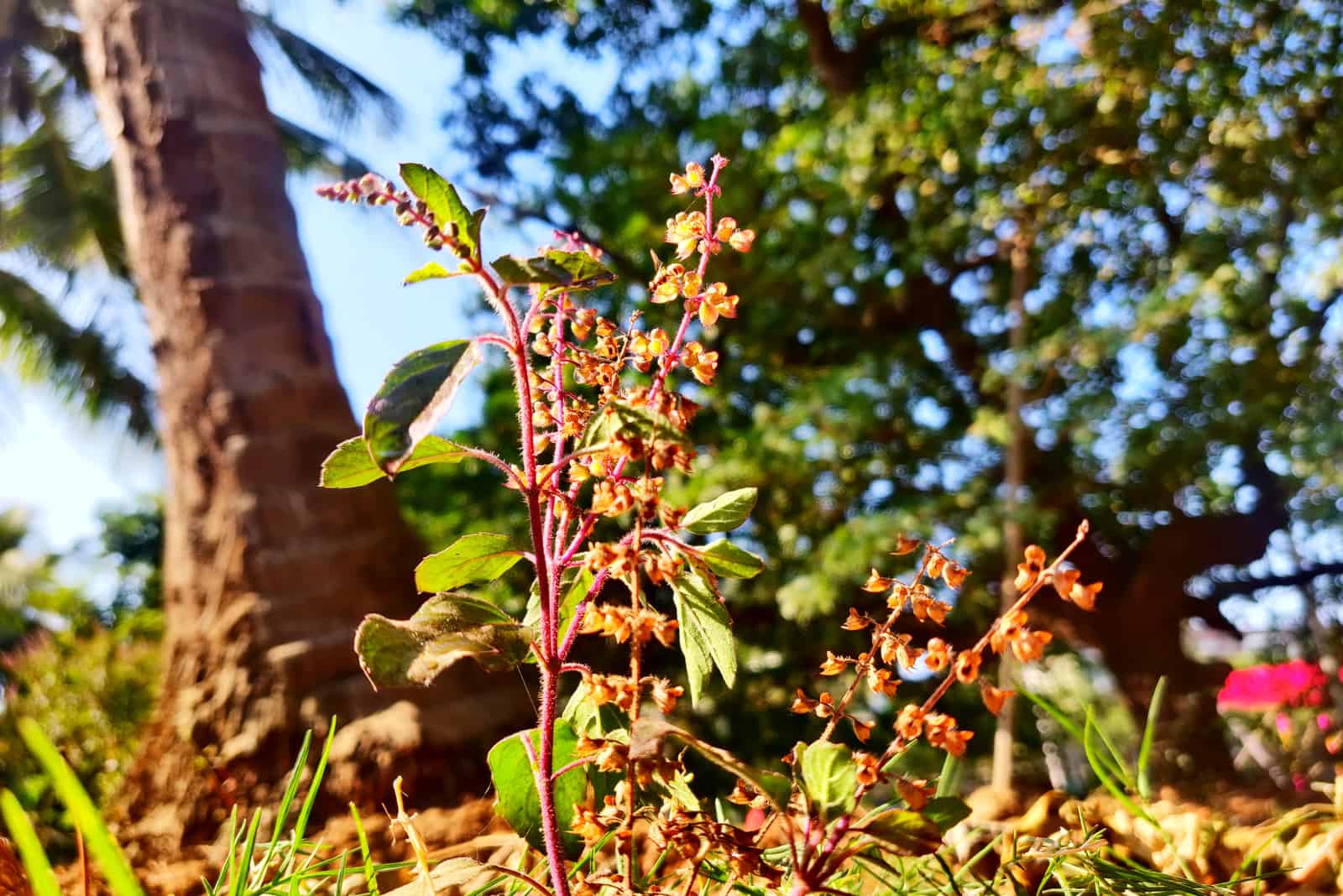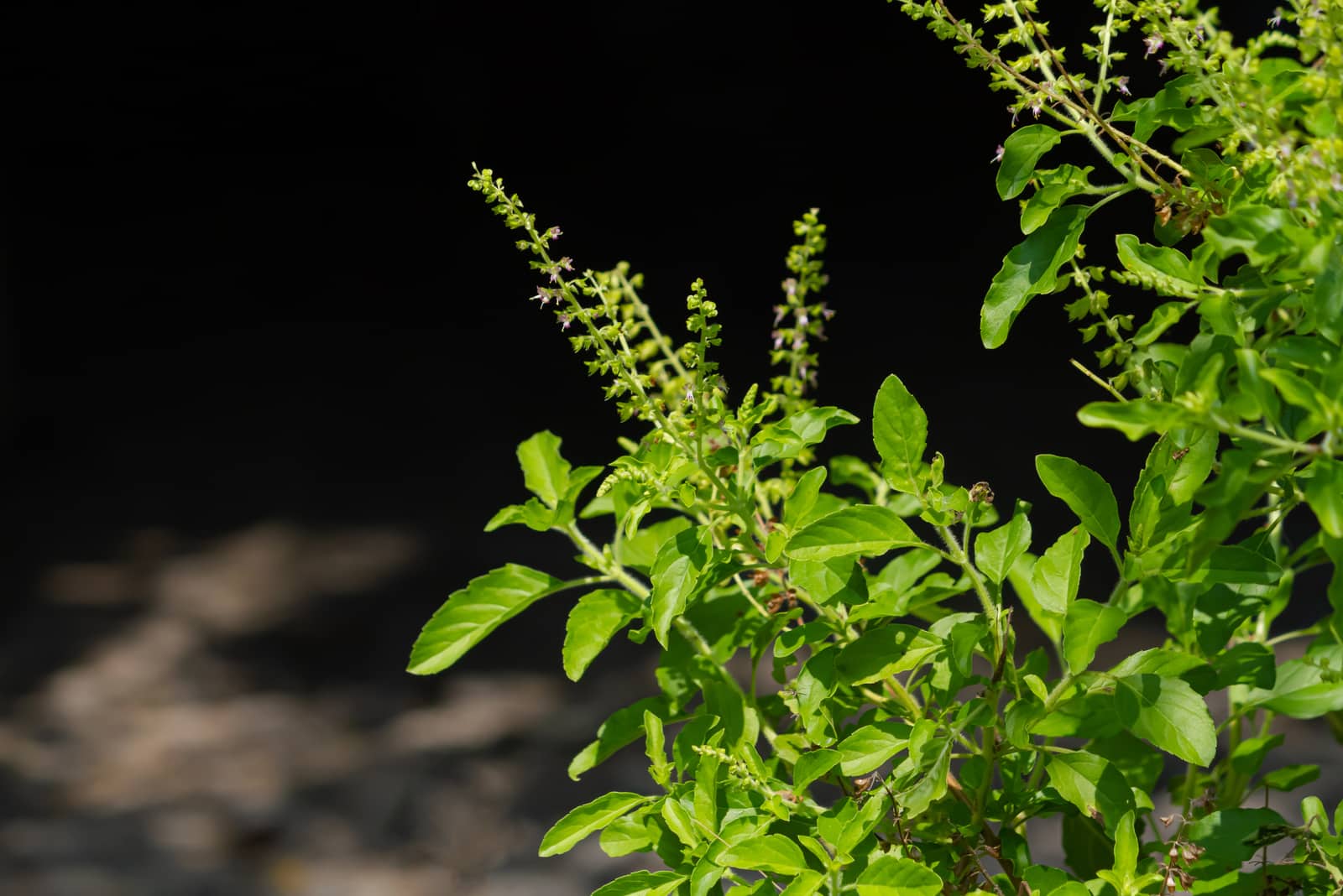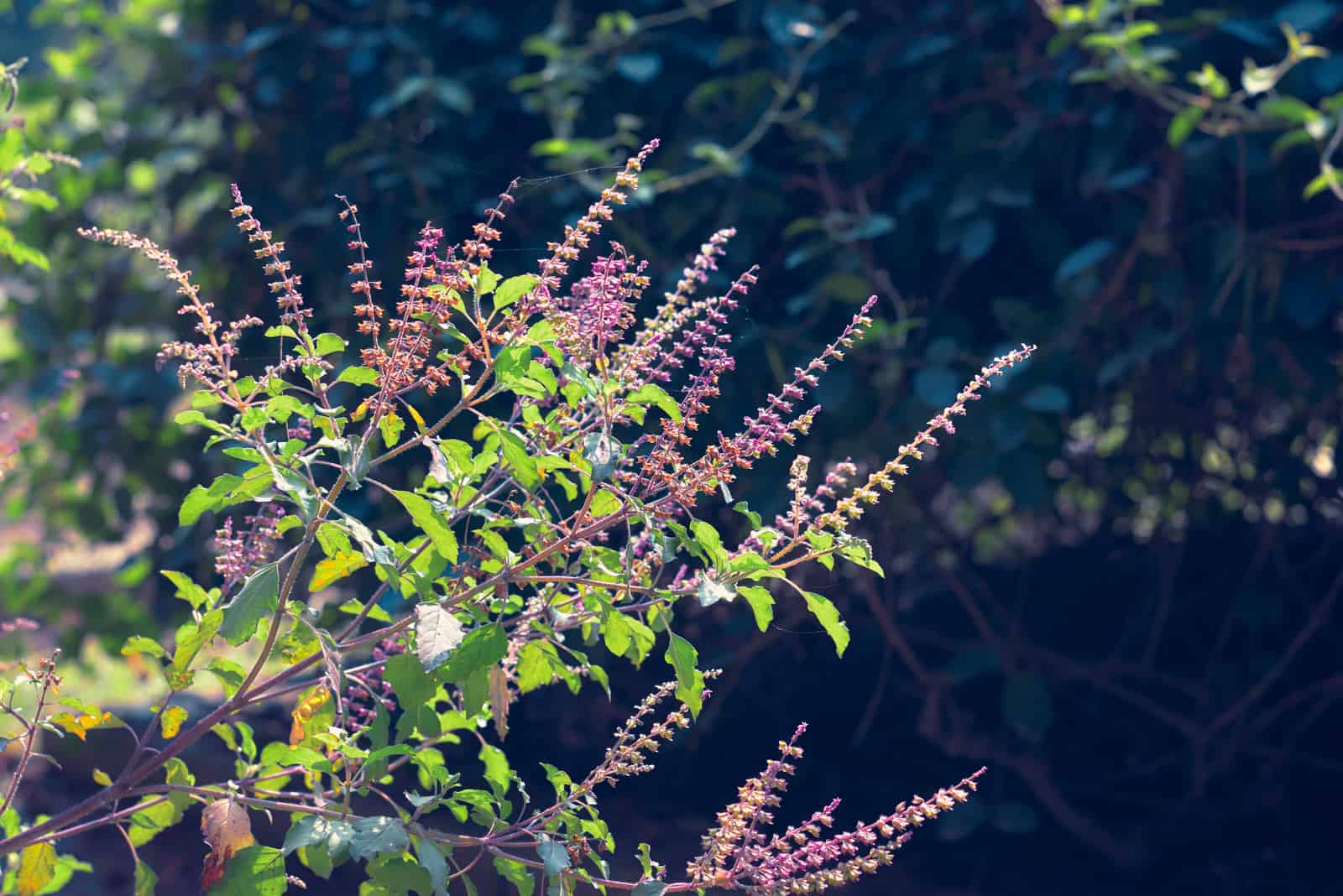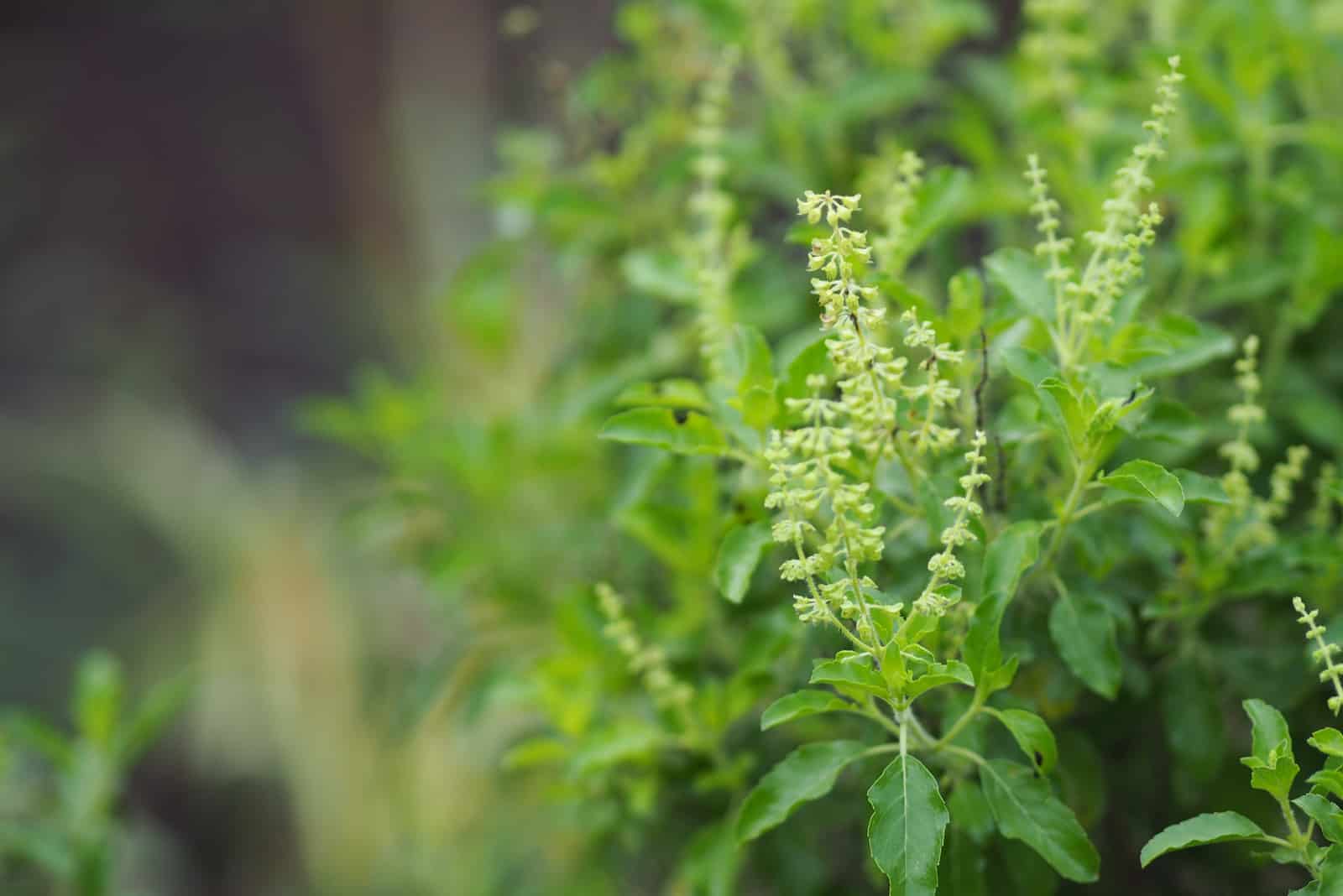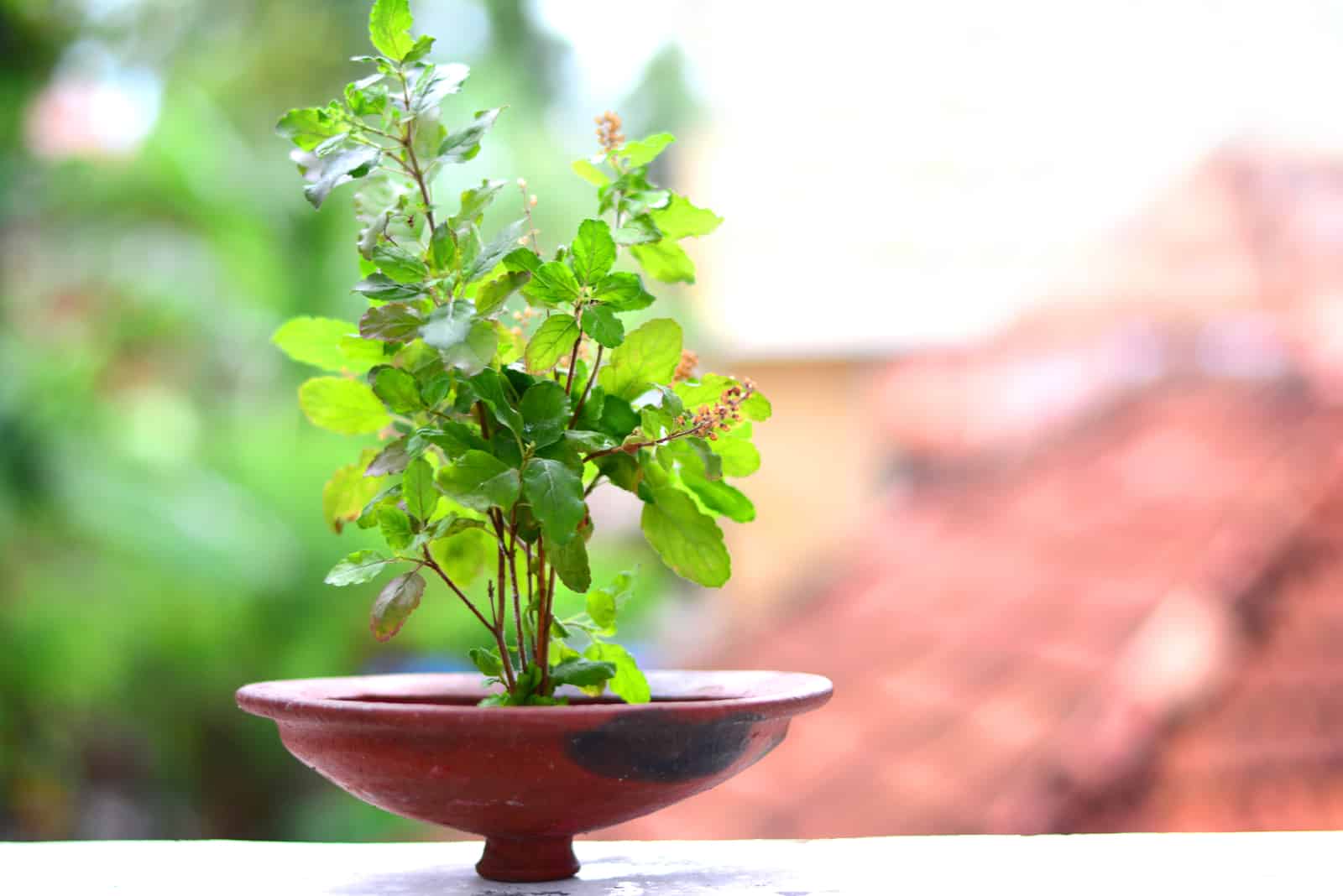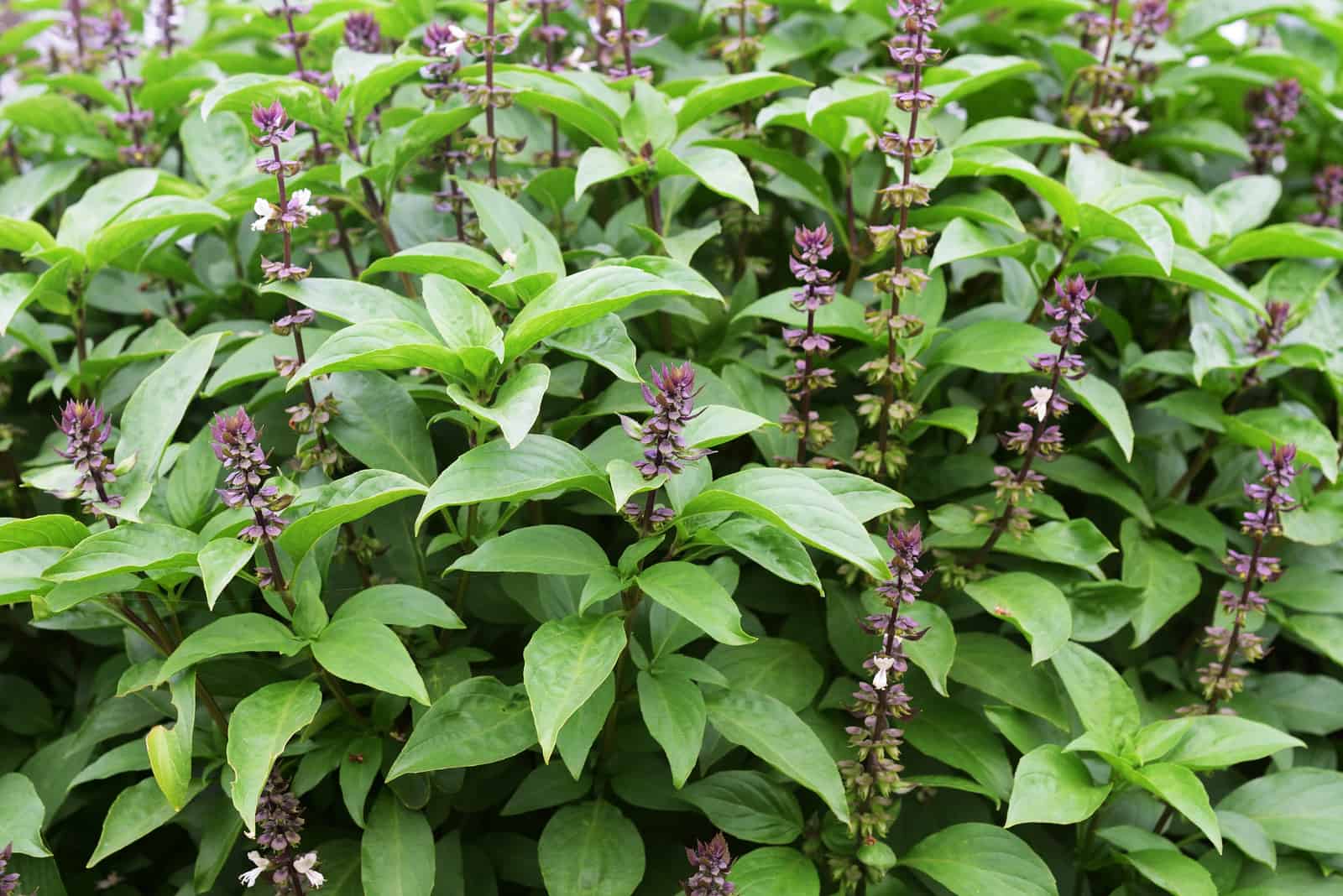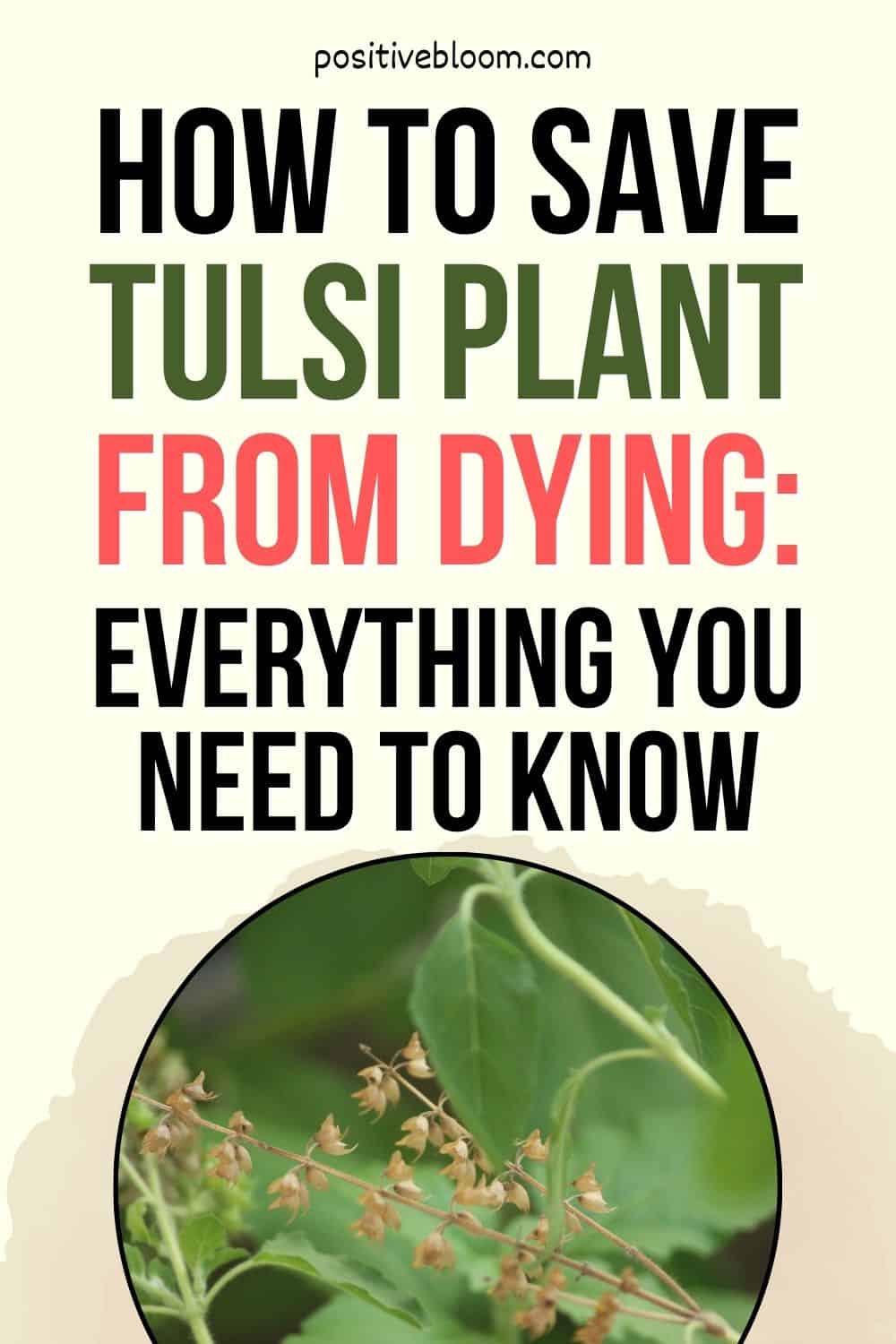Positive Bloom is an Amazon Associate and we earn from qualifying purchases through these links at no extra cost to you.
The Tulsi plant is also known as Tulasi or basil. I’m sure we all have some in our pantries to use in cooking and cocktail making on a hot summer evening.
If you have ever grown basil at home and wondered How to save tulsi plant from dying? This is the article for you.
We will now answer this question and bring you the things you need to avoid if you want to grow basil at home.
First, some general information:
[table id=52 /]
Now that you know some basic things about holy basil, it’s time to learn to recognize if something is wrong with it so you know how to save tulsi plant from dying.
Let’s begin!
How To Save Tulsi Plant From Dying
In this chapter, you will learn to recognize dying basil and the causes behind it. You will also find out how to save tulsi plant from dying in both winter and summer, as well as how to revive the plant if it comes close to death.
4 Signs Of A Dying Tulsi Plant
This section details the four most common reasons for a dying tulsi plant. All you need to do is observe the plant leaves closely, and if you notice something strange, act immediately.
There are different varieties of the tulsi plant, from Kapoor and Krishna Tulsi To Vana and Rama Tulsi.
The most common sign that something is wrong with any variety of tulsi plants is if it quickly loses leaves. However, this is not the only sign of a dying basil plant. Yellow, brown, or black leaves are other indicators that something might be wrong with your basil.
If you notice withered or dried leaves, something is definitely wrong with your basil plant. Eaten leaves are also a sign that your tulsi is not doing very well and needs help.
These are the signs you need to look out for. In the following section, you will find what causes these issues.
Why Is My Tulsi Plant Dying?
There are many reasons your holy basil plant might be dying. The most common cause is inadequate care of tulsi plants in terms of overwatering, low light levels, and over-fertilization.
Other reasons for a dying basil include pest infestations and different diseases.
Let’s now look at the different reasons for a dying basil plant so you can try to avoid them in the future.
Overwatering
One of the main reasons for a dying holy basil is overwatering. If it has been raining extensively for a while, there is no need for you to water the basil as this will only lead to root rot.
You can recognize an overwatered basil plant by its yellow leaves that start to droop and wither. Also, a mature holy basil plant is around 2 feet (60cm) tall, so if you see stunted growth you will know that you’re dealing with overwatering or a similar issue. Whatever it is, it won’t be good.
In addition to the above mentioned reasons, a funny smell coming from the soil is another indicator that something isn’t right with your plant. If you take the plant out of its pot in this case, you will probably notice black or brown roots that are soft.
Our care guide will give you a detailed overview of the watering requirements for basil.
Low Light
Another thing that may cause serious injury to your tulsi is low light. Tulsi plants love light, and they are best grown outdoors.
However, if you’re growing it indoors, you must make sure it gets plenty of sunlight.
You will know that your plant is not receiving enough sunlight if you see its leaves getting paler and paler.
Also, if the plant doesn’t receive enough light, it will try to save energy by not growing any leaves. Plants with only a few leaves need a lot more sun exposure or you can get good grow lights like the ones below and increase the basil yield.
[lasso id=”3146″ link_id=”1343″ ref=”amzn-aerogarden-45w-led-grow-light-panel-black”]
Too Much Sunlight
Another common reason for a dying tulsi plant is too much sunlight. You will notice that your basil is sunburnt because of the yellowing of its leaves.
If your basil plant receives too much sun, it will have dry leaves that are almost crispy to the touch.
Read the care guide below to learn basil’s light requirements!
Over-fertilization
One thing that can cause a lot of damage to basil is over-fertilization. If you notice withering, yellow leaves, it can be a result of over-fertilization, not just overwatering or underwatering.
The first thing you need to do is check the soil. If it’s not too wet or dry, you are probably dealing with over-fertilization.
Other symptoms include brown edges, stunted or no growth at all, leaves falling off, fertilizer burn on leaves, and fertilizer build-up on the topsoil.
However, over-fertilization is not the only problem you may experience using fertilizers. If you use nitrogen-based fertilizers, you will not cause physical damage to your plant, but it will not produce the oils that are essential for its aroma and flavor.
Check our fertilization care tips below!
Pests
One of the main reasons for a dying tulsi plant is pest infestation. Pests cause damage to the plant’s leaves, and the plant won’t survive long with damaged leaves.
The most common pests that attack holy basil are leaf rollers, aphids, tulsi lacewing, spider mites, and whiteflies. The key thing is to deal with them at the beginning of the infestation.
Pesticides and insecticidal soaps such as neem oil can save your basil in no time! However, never spray your plants outside under direct sunlight because this can lead to severe sunburn.
Apply neem oil or other insecticides in the evening, and everything will be fine.
Diseases
Fungal infections such as root rot, powdery mildew, bacterial leaf spot, and seedling blight are all caused by excess moisture in the soil.
It is complicated to treat these conditions, but you can easily prevent them. Follow our watering instructions to avoid these diseases.
The only thing you can do to remedy your plants if they have a fungal disease is remove the infected parts and repot the plant in a container with a well-draining medium. You should also put it somewhere it can get plenty of sunlight and hope for the best!
How To Save Tulsi Plant In Winter
Does tulsi always die in winter? No, but winter plant care is different from summer care. Basil needs plenty of sunlight and warmth, which may be a problem in winter.
Take the plant inside and place it on a windowsill where it can receive plenty of sunlight. It needs warmer conditions to survive, and adjusting the thermostat to room temperature is advised.
Also, Tulasi requires less water in winter than it does in summer. That said, you should still water it when the soil is dry, but with less water.
This plant also needs air circulation to prevent fungal diseases, but putting it below an AC can cause more harm than good.
How To Save Tulsi Plant From Dying In Summer
Basil still requires plenty of sunlight even in the summertime, but you need to protect it from the midday heat.
Put a shade cloth on it or keep it indoors so that it doesn’t get sunburned. You will also need to water the basil more frequently than in winter, but always check the soil before watering. Don’t allow it to completely dry, but also don’t water the plant if the soil is still wet.
How To Revive A Tulsi Plant
Unfortunately, you can’t revive a dead tulsi plant, but you can restore it if it’s only “partly dead” with some dry leaves.
You can revive it by watering it thoroughly and giving it at least six hours of sunlight.
If this doesn’t work, it’s likely that your plant is dead and there’s nothing you can do to help it.
What Are The Benefits Of Holy Basil?
The Tulasi is a significant plant in Hindu culture, but we should all use it in our everyday lives.
The health benefits of basil are numerous, but in short, it is known to reduce stress, can balance the excretion of the hormone cortisol, reduces inflammation, and is antibacterial and an antioxidant, which is why it is used in all kinds of toothpaste to remove plaque build-up.
It can also speed up recovery from flues and common colds, and finally, it can ail your respiratory system by opening up the airways.
Care Guide
Our care guide has some amazing gardening tips for growing basil. Knowing that basil needs light and water isn’t enough; every plant needs that.
In this section, you will see detailed guidelines for growing basil. It needs plenty of sunlight, some water, and a well-draining substrate, and its life span will double.
You can grow it as either an annual or a perennial plant once you learn how to grow tulsi plant from scratch.
Let’s get started!
Light Requirements
Basil needs full sun exposure of 6-8 hours of sunlight every day. Growing it in low light will lead to paler leaves.
However, the hot midday sun can burn your plant, so you should put a shade cloth over your basil or move it somewhere if you’re growing it outdoors.
If you grow basil as a houseplant, you can keep it on an east-facing windowsill.
If your home doesn’t receive much light, you can always invest in grow lights.
Water And Humidity
Basil needs to be watered regularly. You should water tulsi at least once a week with 1 inch (2.5cm) of water.
If you grow basil in a pot, you should water it more frequently, but don’t use more than 1 inch of water a week.
The best time to water your basil is in the morning before you leave for work.
However, if and when the rainy season arrives, you should water the plant less because it already has plenty of moisture.
Remember, overwatering can kill your plant!
Humidity
Basil likes medium to high humidity. Keeping the humidity level between 40-60% is optimal.
If you live in an arid area, there are a few ways you can raise the humidity yourself.
The first method we advise using is the pebble tray method. Put some pebbles in a small tray and place your plant on it. The water will evaporate and raise the humidity level around the basil, and the small stones will prevent the roots from soaking in water.
You can also try misting if you don’t like the pebble tray method. However, let the tulsi leaves dry completely before the next misting because too much moisture can lead to leaf spot and other fungal infections.
Finally, if you’re growing basil indoors, you can always buy a compact humidifier (like the following one) that will nicely fit into the home decor and keep your plant happy.
[lasso id=”3147″ link_id=”1344″ ref=”amzn-raydrop-cool-mist-humidifier-diffuser-2-5l-essential-oil-diffuser-top-fill-humidifier-for-bedroom-home-and-office-baby-humidifier-with-adjustable-mist-output-dial-knob-auto-shut-off-white”]
Climate And Temperature
Basil loves warm and humid climates. It can flourish in temperatures between 72 and 82°F (24-28°C).
However, it can tolerate a wide range of temperatures between 50-85°F (10-29°C). Anything below or above this range can slow down the growth of this plant.
Also, basil can’t tolerate sudden temperature swings and draughts, so if you’re growing it inside, keep it away from the windows and AC.
Soil And Fertilization
The Tulasi requires well-draining soil rich in organic material and nutrients. It prefers a slightly alkaline and neutral pH level, between 6.0-7.0.
You can add compost to provide the basil plant with enough nutrients at the beginning of the season.
After you’ve done that, you’re pretty much done with soil. You only need to keep the soil moist, and that’s it.
You can also mulch your holy basil plant, which will help the soil retain moisture. This way, you won’t have to water the plant as much. Mulching can also raise the temperature of the ground, creating a perfect environment for healthy, aromatic basil.
Fertilization
A bit of fertilizer won’t hurt your herbs. The best fertilizer for both indoor and outdoor basil is organic fertilizer like cow dung.
You should fertilize indoor plants once every month or month and a half, whereas outdoor plants require more frequent fertilization of once or twice a month.
You can also use balanced, all-purpose fertilizer. Be sure you don’t use nitrogen fertilizer, as this will make your basil the most beautiful basil plant ever, but it will make it lose its aroma and flavor.
Transplant And Repotting
Don’t transplant your basil until the temperature is relatively mild. Basil cannot survive transplant shock if the daily temperatures are lower than 70°F (21°C), and night temperatures are below 50°F (10°C).
When the time is right, prepare a well-draining medium and add compost to make the soil more fertile and improve water retention and drainage.
The best time for transplanting is in the early morning so that it can get plenty of sunlight during the day. Water the plant thoroughly after the transplantation to alleviate the transplant shock.
Plant the basil at least 10 inches (25 cm) apart to improve air circulation.
You can also mulch the soil with straw or grass clippings, which will protect the newly transplanted plant from unexpected frost.
Repotting
If you’re growing basil indoors, you might need to repot it.
Here’s how to do it!
Take a new pot larger than the previous one, but not so large that your basil gets waterlogged. Next, make sure that the pot has drainage holes so that the excess water can escape.
Fill the new container with soil mix, then carefully take the basil out of its old pot and place it in its new home. The pot needs to be deep enough so that the basil’s root ball is in the middle of the pot (the top of the root ball should be 1 inch (2.5 cm) below the pot’s rim).
Add more soil mix and close the gap between the roots and the pot’s edges.
Finally, soak the soil with water and allow it to drain through the potholes. Place the plant somewhere it can receive plenty of sunlight, such as an outdoor garden or a windowsill.
Here’s a great video with repotting and transplantation instructions for basil:
Propagation
You can propagate basil from stem cuttings, and it is really quite simple.
Use sterilized scissors so that you don’t transfer any bacteria onto a new or parental plant. Cut a stem 4-6 inches (10-15 cm) long below the leaf node (where the leaf starts).
Clip the stem at an angle to increase the possibility of water absorption. Remove the bottom leaves because they are only a hindrance. If you root the basil in water, the leaves will only rot and contaminate it.
The fastest method is to root the basil in water. Fill a glass with water (if you’re using tap water, leave the glass of water in the air for 24 hours for the chlorine to evaporate).
Mist the leaves and change the water daily, and you should see the root system forming within a week or two if you keep the plant where it can get plenty of indirect sunlight.
When the roots reach 1-2 inches (2.5-5 cm) long, you can move them to a pot filled with moist, fertile, well-draining soil.
All that’s left is to place that plant on an east-facing windowsill and tend to its watering requirements.
You can also check the next video if you’re more of a visual learner like we are.
The 4 Stages Of Basil’s Growth Cycle
If you want to grow basil from seed, here is what you need to know.
There are four stages of basil’s growth cycle. It grows pretty quickly, and if the conditions are just right, you can have basil ready to use in less than a month.
Here’s how to grow basil from seeds.
1. Seed Germination
The first stage is seed germination. After planting tulsi seeds, it usually takes a week or ten days for the seeds to germinate.
The seeds require a warm and moist medium to germinate, and you can cover them with plastic wrap after the germination. This will ensure they have enough moisture and heat.
2. Plant Growth
The next stage is plant growth. After you notice the first set of true leaves, you should divide the seedlings so they have their own place.
You will notice rapid growth, and after the plant has at least six sets of true leaves, you can remove the top leaves because this will encourage healthy growth and make your plant bushier.
3. Maturation
After three or four weeks, your basil plant is mature enough to be used in cooking or in a Gin & Basil Smash cocktail!
4. Flowering
The final stage is flowering. Basil plants produce blooms in summer, near the end of the season. The flowers are also edible, and the leaves won’t become toxic after the basil has flowered.
However, they will lose some of their flavor and aroma, and the plant will produce fewer leaves because more energy goes into flowering.
You can cut off flowers as soon as you notice them to keep your Tulasi plant producing leaves all year round.
FAQ
There are many more questions about basil because they are amazing, versatile plants!
You can use them as remedies, for making teas and drinks, in cooking, for making essential oils, and much more.
Here are the answers to the most common questions about basil plants to help you grow healthy, bushy tulsi plants.
What happens if a Tulsi plant dies?
If your holy basil plant dies, you can revive it if you scratch the brown stem and it is still green inside.
All you need to do is water it and place it somewhere it can receive plenty of bright indirect sunlight. After it gets a little stronger, you can even take it outside in direct light, but be careful the next time.
However, if the stem is dead you should look for seeds. You can use these seeds to grow new plants.
What can I do to help my Tulsi plant grow?
You can make your tulsi plant grow by pinching the small top leaves and removing any flowers.
You also need to meet all the requirements if you want to make it grow faster and healthier. This includes providing it with full sun exposure, regular watering, raising the humidity level if necessary, planting the basil in a fertile, well-draining medium, mulching, and adding a balanced fertilizer.
What is the best environment for a Tulsi?
The best environment for a tulsi is warm and humid with plenty of sunlight. It also requires good drainage and soil rich in organic material and nutrients.
This plant cannot survive in cold temperatures, and low light can result in pale leaves and stunted growth.
To Sum Up
Now that we’re at the end of this article and you know precisely how to save tulsi plant from dying, you can buy as many potted basil plants or seeds as you want, and we’re sure that they will be in a good home!
Basil needs just a little bit of attention to produce its savory leaves in under a month.
This plant is immensely grateful if it gets 6-8 hours of sunlight, 1 inch (2.5 cm) of water a week, and a well-draining soil rich in nutrients.
Until next time!
Like this post? Share or pin it for later!

